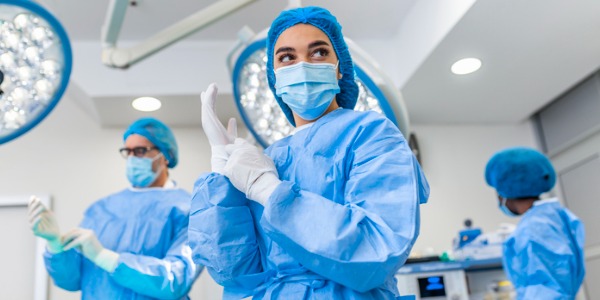What is a Surgical Assistant?
A surgical assistant is a vital member of the surgical team who assists surgeons and nurses during surgical procedures. They are responsible for preparing the operating room, sterilizing instruments, and ensuring that all necessary equipment is ready for the surgery. During the surgery, surgical assistants pass instruments to the surgeon, maintain a sterile field, and assist with any necessary tasks to ensure a smooth and efficient operation.
Surgical assistants maintain patient safety and support the surgical team throughout the procedure. They are knowledgeable in surgical procedures, medical terminology, and aseptic techniques, allowing them to anticipate the surgeon's needs and provide seamless assistance during surgery. Their expertise and attention to detail contribute to successful surgical outcomes and the overall effectiveness of the surgical team.
What does a Surgical Assistant do?

Surgical assistants play a vital role in the operating room by supporting surgeons and the surgical team during procedures. They help ensure that surgeries run smoothly and efficiently, maintaining a sterile environment and providing the necessary instruments and supplies. Their expertise and assistance contribute to patient safety, improved surgical outcomes, and overall quality of care in the operating room.
Duties and Responsibilities
The duties and responsibilities of a surgical assistant can vary depending on their specific role, level of training, and the regulations of the healthcare facility. However, some common duties and responsibilities of surgical assistants may include:
- Preparing the operating room: Surgical assistants help set up the operating room by ensuring that it is clean, sterile, and properly equipped. They arrange surgical instruments, supplies, and equipment, ensuring everything is in working order and readily accessible for the surgical team.
- Assisting with patient positioning: Surgical assistants help position patients on the operating table, ensuring their comfort and safety during the procedure. They may also assist with applying and monitoring patient monitoring devices, such as EKG leads and blood pressure cuffs.
- Sterilizing instruments: Surgical assistants are responsible for sterilizing surgical instruments and ensuring they are properly maintained. This includes cleaning, disinfecting, and assembling instruments according to sterilization protocols to maintain a sterile surgical environment.
- Assisting during surgery: During the surgical procedure, surgical assistants work closely with the surgical team, passing instruments to the surgeon, anticipating their needs, and maintaining a sterile field. They may also hold and manipulate tissues, control bleeding, suction fluids, and assist with wound closure under the direction of the surgeon.
- Post-operative care: After the surgery is completed, surgical assistants may help with transferring the patient to the recovery area, cleaning and restocking the operating room, and documenting the procedure accurately for medical records.
Types of Surgical Assistants
The two primary types of surgical assistants are Certified Surgical First Assistants (CSFAs) and Certified Surgical Technologists (CSTs). Let's explore each type in more detail:
- Certified Surgical First Assistants (CSFAs): CSFAs are advanced-level surgical assistants who have received additional training and certification. They work closely with surgeons during surgical procedures, providing direct assistance in various tasks. CSFAs have an expanded scope of practice that may include suturing incisions, controlling bleeding, providing exposure of the surgical site, and assisting with tissue manipulation. They collaborate closely with the surgical team to ensure the success and safety of the surgery.
- Certified Surgical Technologists (CSTs): CSTs, also known as surgical technologists, are surgical assistants who primarily focus on the technical aspects of surgical procedures. They maintain a sterile surgical environment, prepare the operating room, sterilize instruments, and ensure the availability of necessary supplies. During surgeries, CSTs assist the surgical team by passing instruments, holding retractors, and maintaining a sterile field. They work alongside surgeons, nurses, and other healthcare professionals to support the smooth flow of the surgical procedure.
What is the workplace of a Surgical Assistant like?
The workplace of a surgical assistant is primarily the operating room (OR) within a healthcare facility. This can include hospitals, outpatient surgical centers, ambulatory care centers, and specialized surgical clinics. The OR is a controlled environment specifically designed for surgical procedures, and it adheres to strict sterile protocols to minimize the risk of infections and ensure patient safety.
Within the OR, surgical assistants work alongside a diverse team of healthcare professionals, including surgeons, anesthesiologists, nurses, and surgical technologists. They collaborate closely with the surgical team, communicating and coordinating their efforts to optimize patient care during surgical procedures.
The OR is a fast-paced and dynamic environment, demanding high levels of focus and attention to detail. Surgical assistants may participate in a wide range of surgical specialties, such as general surgery, orthopedics, neurosurgery, cardiovascular surgery, gynecology, and more. This diversity allows surgical assistants to gain experience in different surgical techniques and procedures.
The physical environment of the OR is typically well-equipped with advanced surgical instruments, medical devices, and monitoring equipment. The surgical assistant is responsible for ensuring that the necessary instruments and supplies are organized and readily available for use. They also work with sterile drapes, gowns, and gloves to maintain a sterile field during the procedure.
Additionally, surgical assistants may spend time outside of the OR for tasks such as pre-operative patient preparation, post-operative care, and administrative duties related to surgery scheduling and documentation.